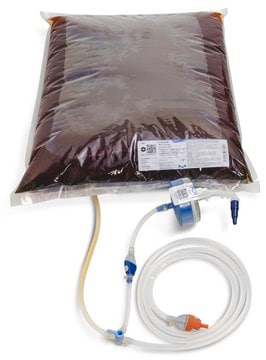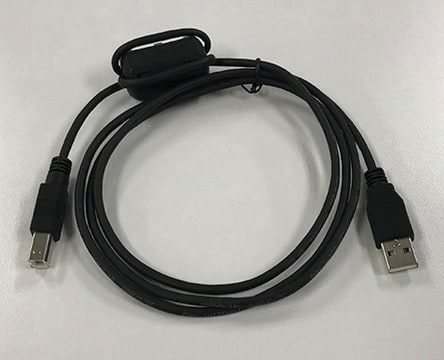While operating pressures may not exceed the 400 bar (6,000 psi) capability of your traditional instruments, sustained pressures of about 200 bar (3,000 psi) will exceed the recommended pressure for conventional PEEK tubing and fittings at the column inlet. We recommend changing to stainless steel fittings in all high pressure locations and have designed special High Performance HPLC Fittings/Interconnects that will stay tight at pressures of 1,000 bar (15,000 psi) or greater, even when elevated column temperatures are employed.
53812-U
Ascentis® Express 90 Å C18 (2.7 μm) HPLC Columns
L × I.D. 7.5 cm × 3 mm, HPLC Column
Wybierz wielkość
3360,00 zł
Wybierz wielkość
About This Item
3360,00 zł
Polecane produkty
Nazwa produktu
Ascentis® Express C18, 2.7 μm HPLC Column, 2.7 μm particle size, L × I.D. 7.5 cm × 3 mm
Materiały
stainless steel column
Poziom jakości
agency
suitable for USP L1
linia produktu
Ascentis®
Właściwości
endcapped
producent / nazwa handlowa
Ascentis®
opakowanie
1 ea of
Parametry
60 °C temp. range
600 bar max. pressure (9000 psi)
metody
HPLC: suitable
LC/MS: suitable
UHPLC-MS: suitable
UHPLC: suitable
dł. × śr. wewn.
7.5 cm × 3 mm
powierzchnia
135 m2/g
zanieczyszczenia
<5 ppm metals
Matryca
Fused-Core particle platform
superficially porous particle
grupa aktywna macierzy
C18 (octadecyl) phase
wielkość cząstki
2.7 μm
wielkość porów
90 Å
pH robocze
2-9
Zastosowanie
food and beverages
metoda separacji
reversed phase
Szukasz podobnych produktów? Odwiedź Przewodnik dotyczący porównywania produktów
Opis ogólny
Visit the Ascentis Express home page for more information on this new column technology.
Zastosowanie
Informacje prawne
Zastosowanie
kartridż do prekolumny
produkt powiązany
Hasło ostrzegawcze
Warning
Zwroty wskazujące rodzaj zagrożenia
Zwroty wskazujące środki ostrożności
Klasyfikacja zagrożeń
Skin Sens. 1
Kod klasy składowania
10 - Combustible liquids
Klasa zagrożenia wodnego (WGK)
WGK 3
Temperatura zapłonu (°F)
Not applicable
Temperatura zapłonu (°C)
Not applicable
Wybierz jedną z najnowszych wersji:
Certyfikaty analizy (CoA)
Nie widzisz odpowiedniej wersji?
Jeśli potrzebujesz konkretnej wersji, możesz wyszukać konkretny certyfikat według numeru partii lub serii.
Masz już ten produkt?
Dokumenty związane z niedawno zakupionymi produktami zostały zamieszczone w Bibliotece dokumentów.
Produkty
Derivatization of Aliphatic Amines - Results from the Supelco Ascentis Express column show higher peak resolution, and improved peak shapes than typical chromatograms.
Chromatograms
application for HPLCapplication for HPLC-
Do I need special fittings and tubing to connect Ascentis® Express HPLC Columns?
1 answer-
Helpful?
-
-
What is the carbon load for Ascentis® Express C18 HPLC Columns?
1 answer-
Carbon load which is commonly referred to as %Carbon is misleading and not meaningful for Ascentis® Express. Since Fused-Core™ particle is unique in the sense that it has a solid core and porous shell, the %Carbon number can not be compared to traditional porous particles. The carbon coverage for Ascentis® Express C18 is 3.5 micromoles/meter-squared
Helpful?
-
-
What is the Department of Transportation shipping information for this product?
1 answer-
Transportation information can be found in Section 14 of the product's (M)SDS.To access the shipping information for this material, use the link on the product detail page for the product.
Helpful?
-
-
Can Ascentis® Express HPLC Columns be used for LC-MS?
1 answer-
Express Fused-Core™ particles were designed with LC-MS in mind. Even extremely short column lengths exhibit sufficient plate counts to show high resolving power. The flat van Deemter plots permit resolution to be maintained at very high flow rates to maximize sample throughput. All Ascentis stationary phases have been evaluated for MS compatibility during their development, and the Express phases are no exception. You can expect extremely low column bleed and background while maintaining longest possible column lifetime. A bonus of Ascentis Express columns for high throughput UHPLC and LC-MS is that they are extremely rugged and highly resistant to plugging, a very common failure mode for competitor columns.
Helpful?
-
-
Can I use Ascentis Express on any type of HPLC system?
1 answer-
Ascentis Express HPLC columns are capable of use on standard HPLC systems as well as UHPLC systems. Columns are packed in high pressure hardware capable of withstanding the pressures used in UHPLC systems.
Helpful?
-
-
Is there anything special I need to do to my HPLC system to use Ascentis Express?
1 answer-
Nothing special is required to use Ascentis Express HPLC columns. To obtain the full benefits of Ascentis Express, one should minimize dispersion in the HPLC system (tubing, detector flow cell) as well as confirm the detector response system is set at a fast level. For more information, request Guidelines for Optimizing Systems for Ascentis Express Columns (T407102).
Helpful?
-
-
How can I measure my instrument bandwidth (IBW) and determine what Ascentis® Express HPLC Columns can be used with minimal efficiency loss created by too much internal instrument volume?
1 answer-
The Guide to Dispersion Measurement has simple instructions on how to measure IBW and can be found at sigma-aldrich.com/express.
Helpful?
-
-
Can I use Ascentis Express on a UHPLC system?
1 answer-
Yes. Ascentis Express columns are packed in a way making them suitable for these ultra high pressure instruments. In fact, Ascentis Express outperforms sub-2 μm micron columns on many applications since Ascentis Express provides the benefits of sub-2 μm particles but at much lower back pressure. These benefits include the capability of providing fast HPLC and higher resolution chromatography. The Fused-Core particle consists of a 1.7 μm solid core and a 0.5 μm porous shell. A major benefit of the Fused-Core particle is the small diffusion path (0.5 μm) compared to conventional fully porous particles. The shorter diffusion path reduces axial dispersion of solutes and minimizes peak broadening.
Helpful?
-
-
What flow rate should I use with Ascentis® Express HPLC Columns?
1 answer-
Based on the minimum in the van Deemter curves, higher flows than 5um particle columns are required in order to maximize Ascentis Express column efficiency. The suggested starting point for flow rate for Ascentis Express columns: 1.6 mL/min for 4.6 mm ID; 0.8 mL/min for 3.0 mm ID; and 0.4mL/min for 2.1 mm ID.
Helpful?
-
Active Filters
Nasz zespół naukowców ma doświadczenie we wszystkich obszarach badań, w tym w naukach przyrodniczych, materiałoznawstwie, syntezie chemicznej, chromatografii, analityce i wielu innych dziedzinach.
Skontaktuj się z zespołem ds. pomocy technicznej









